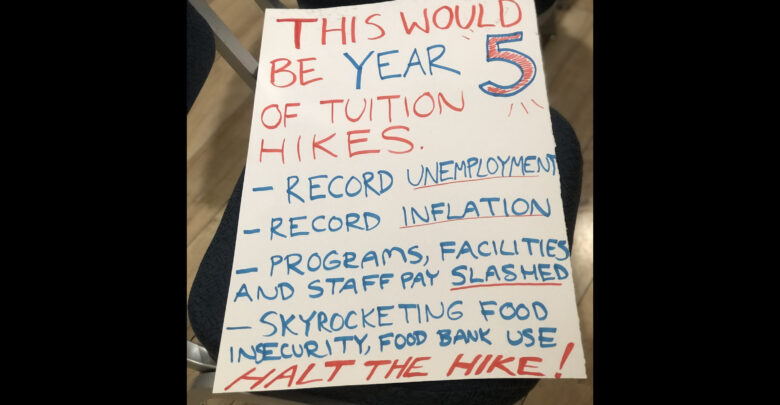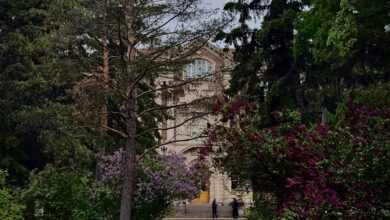U of A students voice concerns to administration at tuition town hall
“It’s sounding like tuition is intended to cover the cost of education. But ultimately, the experience students are receiving in their education is plummeting," student says.
 Aparajita Rahman
Aparajita RahmanThe Gateway is looking to expand its coverage on tuition increases and the affordability crisis ahead of the March 22 Board of Governors meeting, where proposed tuition increases will be voted on. To share your thoughts on tuition increases and help The Gateway broaden coverage, fill out this confidential form.
On January 19, approximately 50 students attended a tuition town hall in the Students’ Union Building (SUB) at the University of Alberta. The U of A Students’ Union (UASU) collaborated with the Graduate Students’ Association (GSA) to hold the event.
Members of the Tuition Budget Advisory Committee (TBAC) — such as Melissa Padfield, deputy provost (students and enrolment) — attended to present on proposed tuition hikes and answer students’ questions.
The proposal includes a two per cent tuition increase for domestic students in 2024-25, and a five per cent increase for international students in 2025-26. As an exception, tuition for international undergraduate science programs are proposed to increase by 6.5 per cent.
As well, international students who enrolled at the U of A prior to fall 2020 (cohort 99) will transition from the registration-based tuition model to the program-based model in fall 2024.
Multiple students arrived to the town hall with signs protesting the proposed tuition hikes. To produce these, the Alberta Public Interest Research Group (APIRG) held a sign-making session prior to the event.
Padfield presents on cost-drivers and inflationary pressures behind proposed tuition hikes
In her presentation, Padfield outlined that the tuition increases are in line with the Consumer Price Index (CPI). CPI tracks the price change of consumer goods annually and acts as a measure of inflation. According to Padfield, the Government of Alberta has indicated that for the U of A, the CPI is approximately five per cent.
Padfield noted that rises in cost-drivers have a direct effect on tuition hikes. For example, CPI leads to an increase in expenses related to materials and supplies. According to Padfield, these items constitute 13 per cent of the university’s overall costs.
Furthermore, she stressed the importance of tuition covering aspects of program delivery. This encompasses instructor salaries, classroom maintenance, study spaces, and supplies. Additionally, tuition plays a role in supporting research initiatives and providing financial assistance to students.
Padfield mentioned that the university is currently dealing with revenue shortfalls. Between 2020 and 2023, the Government of Alberta reduced the U of A’s provincial grant by $222 million.
“That certainly makes it challenging for us to be able to continue offering the quality education that we are committed to,” Padfield said.
Students are paying more for a “lower quality education,” student says
Following Padfield’s presentation, several students lined up to voice their concerns and ask questions.
“It’s sounding like tuition is intended to cover the cost of education,” one student stated. “But ultimately, the experience students are receiving in their education is plummeting.”
They mentioned barriers in accessing “essential services,” which students continue to pay for, especially following the closure of the Humanities Centre.
For example, students seeking services at the U of A Sexual Assault Center (UASAC) are being “turned away,” the student said. In addition, the student mentioned that people are “having more challenges” accessing academic advising in a timely manner.
“Why are students paying more to receive a lower quality education with less support and diminishing campus experiences?” the student asked Padfield.
Padfield answered that, to her knowledge, the UASAC and other psychological support services are currently available to students in need. Additionally, Padfield said that more than 8,000 U of A students responded to the Student Experience Action Plan (SEAP) survey. Those surveyed provided input on areas of growth, but also services they “really appreciated.”
“We want to make sure that we can preserve the good things that currently happen at the university,” Padfield said. “And in order to do that, we have to have a sustainable financial picture.”
The U of A has a “discrepancy” in building maintenance across faculties, arts student says
A student asked why despite arts students paying comparable tuition to non-arts students, there is a discrepancy in the maintenance of arts faculty buildings. This student said that the recent damage to the Humanities Centre and Tory Building is “proof” of this discrepancy.
By 2025, the university will have $1 billion in deferred maintenance costs across its five campuses. Padfield clarified that the government is not contributing to these funds.
She added that the SEAP has “heard [students] loud and clear” about building maintenance, cleanliness, and accessibility issues.
“We want to be able to invest as much as we possibly can,” Padfield said. “We’ve been able to find dollars to improve the level of cleanliness for students spaces across campus. [This is] not focused around any one faculty. But, rather around where students gather in the major occupancy areas of campus.”
Padfield encouraged students to respond to the SEAP’s survey this winter semester, in order to provide feedback on these changes. She said investing in creating accessible lecture halls — primarily in the Tory Building, which is “an arts-occupied space” — is also a part of SEAP.
Students are “turning away” from U of A due to how reliant the quality of education is on the government, GSA vice-president (student life) says
In an interview with The Gateway, Rija Kamran, vice-president (academic) of the GSA, said the tuition hall was held to encourage transparency around proposed tuition hikes.
The GSA is present at some of the tables where discussions surrounding tuition increases occur, such as General Faculties Council (GFC), Kamran said. However, decisions regarding tuition increases are not usually made outside of the Board of Governors (BoG). As such, Kamran said it’s important for people to come out to tuition town halls, which consultation committees attend, and voice their concerns. Because, “that’s the only thing that makes a difference.”
In her advocacy, GSA Vice-president (student life) Tiffany Kung has heard “a million things” from graduate students concerning tuition increases, she said.
“People are going homeless. People are going hungry. International graduate students are turning away from the U of A,” Kung said. “All the students that I know are recommending that no new students come to the U of A because of how bad it is here — how reliant the quality of education is on the government.”
“Our pay hasn’t gone up proportionally. But of course, our tuition has grown,” GSA vice-president (student life) says
In August, the GSA conducted a survey where 40.9 per cent of respondents said they had considered dropping out “to work or save money due to the cost of living.”
”We contribute [around] 90 per cent of the total research that’s done at the university. We do a lot of teaching that’s done at the university, and our pay hasn’t gone up proportionally,” Kung said. “But, of course, our tuition has grown.”
Even if graduate students receive funding, “it’s not enough to cover [the] cost of tuition, make money, and also contribute to the academic experience for undergraduate students,” Kamran said.
”It’s very essential that if the university does plan on increasing tuition, it is also directly reflected in the pay that [graduate] students [receive]. So there is no direct financial impact on them,” Muneeb Masood Raja, GSA associate vice-president (labour) said.
“We’ve seen progress in tuition transparency, and we’ve communicated that progress hasn’t been great enough,” UASU vice-president (external) says
During the tuition town hall, many students voiced concerns regarding accessibility of resources and services.
Chris Beasley, UASU vice-president (external), told The Gateway that the UASU has consistently communicated that tuition transparency is a priority for students.
“We’ve seen progress in tuition transparency, and we’ve communicated that that progress hasn’t been great enough,” Beasley said.
The UASU will be releasing plans on social media to tackle tuition hikes. However, Beasley thinks that the campus community needs to collectively communicate current student affordability pressures.
“We’re gonna need the community to come together and really speak with one voice on this.”



